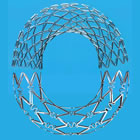|
Dr. William Wijns, one of the study's co-principal investigators, presented the findings at ESC 2012 as part of a late-breaking clinical trials session. The results of PROTECT the largest prospective randomized drug-eluting stent trial ever presented and powered for stent thrombosis - were simultaneously published by The Lancet. The study was sponsored by Medtronic, Inc. (NYSE: MDT). Involving more than 8,700 patients at 196 centers in 36 countries across five continents, PROTECT was initiated to study the occurrence of a rare but serious adverse event known as stent thrombosis the formation of a blood clot inside the stent, which serves as a scaffold to keep the artery open. Stent thrombosis is often associated with serious clinical events, such as cardiac death and myocardial infarction (heart attack). PROTECT (n=8,709) randomly assigned study patients to receive the Endeavorฎ zotarolimus-eluting stent from Medtronic or the Cypherฎ sirolimus-eluting stent from Johnson & Johnson in equal numbers. On the primary endpoint, the trial showed very low rates of definite/probable stent thrombosis with no statistically significant difference in cumulative rates through three years of follow-up: 1.42 percent for Endeavor; 1.79 percent for Cypher (p=0.224). However, stent thrombosis rates after one year, known as very late stent thrombosis, were significantly lower with Endeavor (0.3 percent) compared to Cypher (1.1 percent, p<0.001). "Based on its excellent clinical outcomes and low rates of stent thrombosis through three years of follow-up, PROTECT confirms the long-term safety of percutaneous coronary intervention with these drug-eluting stents," said Dr. Wijns, an interventional cardiology and co-director of the Cardiovascular Center in Aalst, Belgium. "The decline in stent thrombosis rates since the initial concern emerged at ECS 2006 cannot be denied. This likely results from a combination of factors: improvements in patient selection and procedural techniques, and duration and/or compliance with dual antiplatelet therapy." Dual antiplatelet therapy usage in PROTECT followed current ESC and AHA/ACC/ SCAI guidelines, with 88 percent of patients remaining on dual antiplatelet therapy at one year and 30 percent of patients at three years. As with stent thrombosis, the study's secondary endpoints resulted in low, comparable rates of death and large, non-fatal myocardial infarction through three years of patient follow-up: 5.3 percent for Endeavor; 6.0 percent for Cypher (p=0.16). Also of note were the low rates of target vessel revascularization at three years: 8.2 percent for Endeavor; 7.1 percent for Cypher (p=0.03). While drug-eluting stents have been shown to significantly reduce restenosis (the renarrowing of the treated arterial segment) compared to bare-metal stents, post-hoc and pooled analyses at ESC 2006 indicated potential differences in stent thrombosis rates between bare-metal stents and drug-eluting stents. These analyses caused concern of very late stent thrombosis with drug-eluting stents. In 2007 the U.S. Food and Drug Administration (FDA) recommended that larger and longer studies be conducted to assess the risk of infrequent events, such as stent thrombosis. The FDA also recommended focusing on important safety end points (death and heart attack) and on the appropriate duration of dual antiplatelet therapy. PROTECT was funded by Medtronic to help address these issues. Several large meta-analyses have been conducted to better understand the rates of stent thrombosis with drug-eluting stents. However, due to their individual limitations, study designs and retrospective nature, they are ultimately insufficient to show with statistical certainty a difference in low frequency events. These factors often make their results hypothesis-generating rather than definitively conclusive. PROTECT is the largest prospective randomized drug-eluting stent trial ever presented and powered for stent thrombosis. In collaboration with leading clinicians, researchers and scientists worldwide, Medtronic offers the broadest range of innovative medical technology for the interventional and surgical treatment of cardiovascular disease and cardiac arrhythmias. The company strives to offer products and services that deliver clinical and economic value to healthcare consumers and providers around the world. About Medtronic Any forward-looking statements are subject to risks and uncertainties such as those described in Medtronic's periodic reports on file with the Securities and Exchange Commission. Actual results may differ materially from anticipated results. Source: Medtronic, Inc. |

